Before we take the trip up the coast as we promised in our last post, we wanted to detail two other notable sites we toured in Savannah: Tybee Island Light Station and The National Museum of the Mighty Eighth Air Force. The former has guided mariners in some shape or form along the Georgia shore for almost 300 years. The latter honors the men and women who served and are serving in the Eighth Air Force, which was founded in Savannah in 1942.
Tybee Island Light Station
We will begin with the Tybee Island Light Station. First ordered by General James Oglethorpe back in 1732, the beacon started its career as a simple day-mark; in other words, there wasn’t a light associated with it. The octagonal brick structure stood ninety feet tall. Unfortunately, it was built too close to the shore and storms destroyed it in 1741. The next year, a slightly taller day-mark was built, this time with a flagpole on top. Even though this one was further away from the shore, the sea eventually reached the tower. A third tower was completed in 1773. That tower was 60 feet of brick, topped with 40 feet of wood. In 1791, a light was added to the day-mark.
When the Confederate troops abandoned Tybee Island in 1861, they burned the wooden portion of the beacon to prevent Union soldiers from using it. After the war, the tower was increased in size to it’s current height, using the original 60 foot brick tower as it’s base.
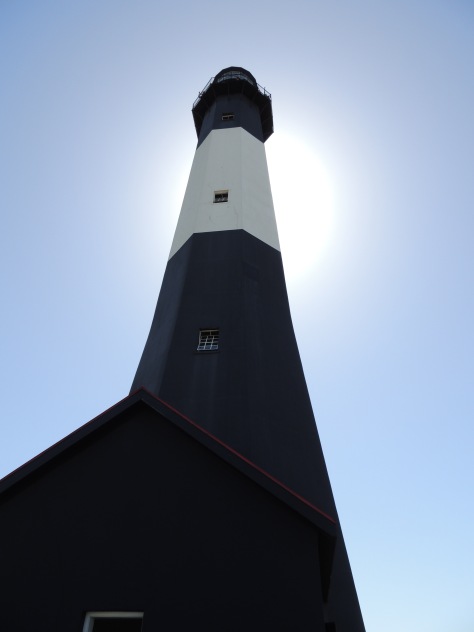
That is what we see today. Currently standing at 145 feet, it is the tallest lighthouse in Georgia. There are 178 steps that take visitors to the top to view the fixed first order Fresnel lens.
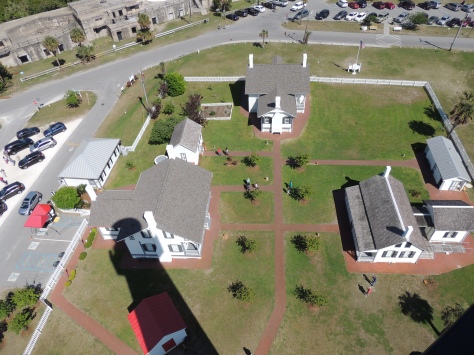
Having climbed it, we have serious respect for the men who kept the light burning. As we were waiting to enter, an older Southern gentleman exited, looked at the ticket-taker and said ” If I win the lottery, I am gonna take a whole bunch of that money and build y’all an elevator to the top of that thing!” We all got a good laugh out of that. 🙂
The rest of the station’s buildings are intact and restored with period furnishings.

We toured the head keeper’s house, which was built in 1881.
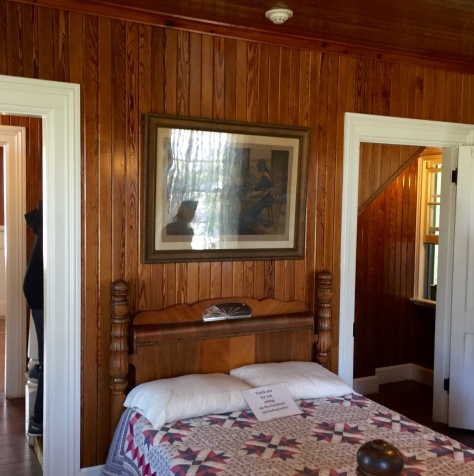
One thing we found unique was the tongue-in-groove southern pine walls and ceilings. They really gave the home a warm, cozy feel.
National Museum of the Mighty Eighth Air Force
The other highlight of this trip to Savannah was the National Museum of the Mighty Eighth Air Force.
This division of the military currently consists of over 16,000 personnel whose primary mission is to keep America safe by operating and maintaining our long-range bombers. They were established in 1942 with the same goal in mind. Back then, they flew B-17 and B-24 bombers out of approximately 100 bases in England on daylight runs over Nazi Germany. They also provided fighter escort for those big planes.
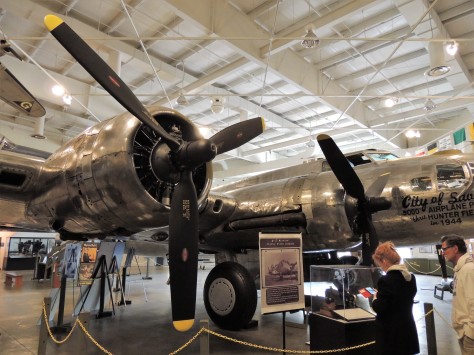
The museum has a gorgeous B-17 Flying Fortress as its centerpiece. On any given day, hundreds of these planes would be in the air. One day in early 1944, Jimmy Doolittle led over 1,000 B-17’s across Europe to bomb Berlin. It is difficult to imagine the sheer terror that must have existed on the ground that day. At that time this division of the Army Air Corps had 200,000 people in their ranks, and had the capability of putting 3,000 bombers and fighters in the air on any given day…hence, the ‘Mighty’ as a prefix.
As we toured this building, the story of the Mighty Eighth was detailed through photos, videos, and displays. As far as military museums go, this was what I would consider one of the better ones…as it personalized the war. Stories from both sides were told along the way, making for a compelling afternoon.
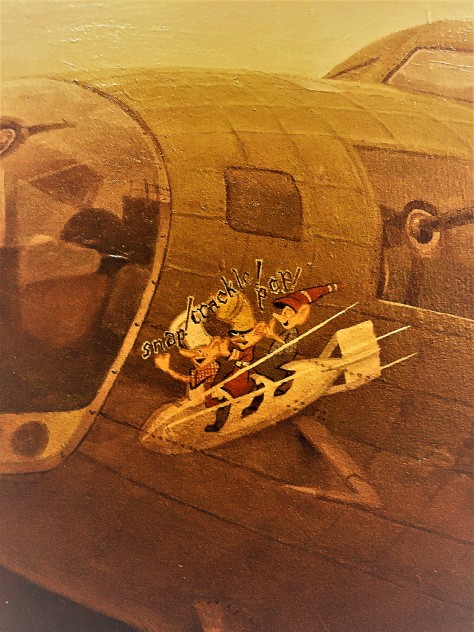
One such story was of the plane “Snap, Crackle, and Pop”. The pilot of this plane, depicted in a mural at the museum, was from Battle Creek, Michigan, home of Kellogg’s Cereal. He received permission, before flying the plane to England, to stop home and have one of the company artists paint the Rice Krispies trio on the front of the plane. Sometime later in the war, the B-17 was shot down over France, and only two parachutes were seen exiting the aircraft.

Actually the ball turret gunner, a man by the name of Alan Magee, also got out of the plane…but without his parachute. You see, this position in the B-17 is so small, the gunner would have to leave his parachute above him in the fuselage. By the time he got to it, the bomber was disintegrating and he was thrown clear. He fell 20,000 feet and crashed through the glass roof of the railroad station in St. Nazaire, France. A German doctor saved his life by doing surgery on his many injuries. The surgeon told him, “I am a doctor first, and a German second.” Magee lived to be 84 years old.
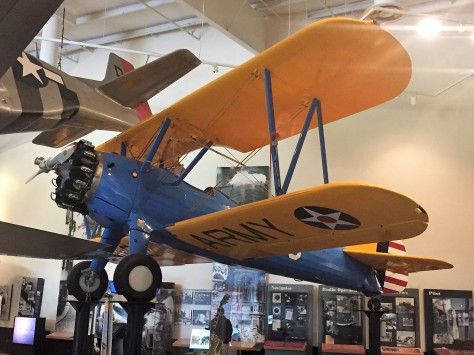
There was also a reminder of a story my father told me when he learned to fly in one of these Stearman trainers during the war. His instructor told him to do a ‘carrier landing’, which was to put the tail wheel on the ground before the front wheels. The maneuver simulated what a pilot would do on an aircraft carrier when they put their tail hook low enough to grab the cable on the deck.
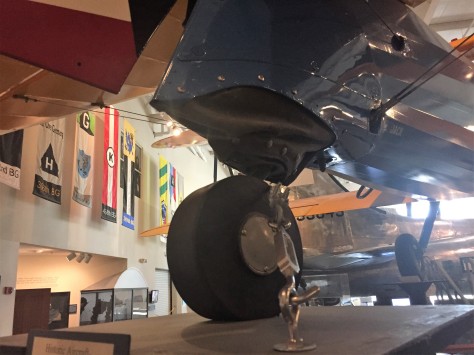
The tail wheel hit the runway hard and smashed the entire assembly up into the plane. When Dad saw the damage, he feared he had totally screwed up. The instructor looked at him and said “Perfect!” 🙂
The exhibits also included stories of the Tuskegee Airmen, and the WASP’s…the non-combat women pilots who delivered planes to bases during the war.
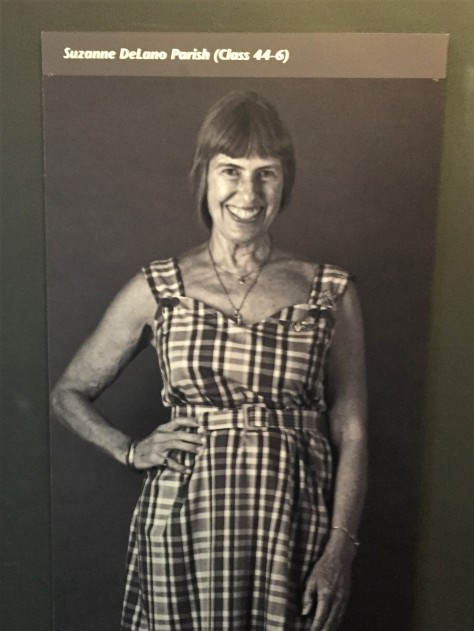
One of those women was Suzanne Parish. She and her husband started the Air Zoo in Kalamazoo, Michigan. Back when I was in college, I would see her buzzing over campus in her pink P-40 Warhawk. Little did I know at the time of her invaluable service during the war. If you want to read more about the Air Zoo and see a photo of her beloved pink aircraft, follow this link.
That wraps up our tour of Savannah, Georgia for this year. We are sure to be back, as we left so much to discover on a future trip. Next up: Charleston, South Carolina. We hope you tag along to see what we find there!

I miss out on the Mighty Eighth museum I will have to plan on seeing it next time thanks for sharing the history.
Safe travels to you guys, love you Rick
LikeLiked by 1 person
It was really well done, Rick. Easy on and off I-95 at Pooler, just west of Savannah. Safe travels to you also!
LikeLiked by 1 person
I find lighthouses fascinating, yet we have never been to one. We are going to have to make a point of getting to one!
LikeLiked by 1 person
Oh, my….and you are from Wisconsin, Jim! Time to get you two up a tower!
LikeLike
We loved the Lighthouse too! No time for the museum this time but Jim will love to see it the next go around. Love the story about you seeing Suzanne Parish in flight as a young man. Makes the story and history so personal 🙂 Hope to see you two in Charleston….
LikeLiked by 1 person
Sounds good, Brenda! Yes, the lighthouse was really cool! You wrote a great post about it, and I loved your photos. (Go check it out by clicking her avatar, folks!). Did you follow the link to see her pink plane? It sounded as sweet as it looks.
LikeLike
The keeper’s house is beautiful – a nice bonus for having to climb all those stairs! So many great stories from the museum and your own experiences. Incredible that Magee survived!
LikeLiked by 1 person
That was one of the prettier keeper’s houses we’ve ever seen, Jodee. And the museum: while war is a difficult subject, those displays really brought it home.
LikeLike
I can’t wait to visit the museum next time we are in Savannah. We hadn’t even heard of it. Great photos, too! Safe travels. I’m excited to hear about Charleston–we’ve never been there! Dawn
LikeLiked by 1 person
Thanks, Dawn!
LikeLiked by 1 person
Sounds like a wonderful visit. Fred and I love Tybee Island. It’s one of those places that could feel like home.
LikeLiked by 1 person
It’s pretty laid back, for sure!
LikeLike
We would really enjoy this museum, especially John. After reading about Alan Magee in your post, John had to do more reading. Wow! Alan had so many injuries. It is amazing that he survived at all, yet to live to be 84! Thanks for sharing some very interesting stories!
LikeLiked by 1 person
My pleasure, Pam!
LikeLiked by 1 person
Great historical information.
LikeLiked by 1 person
Thanks, Linda!
LikeLiked by 1 person